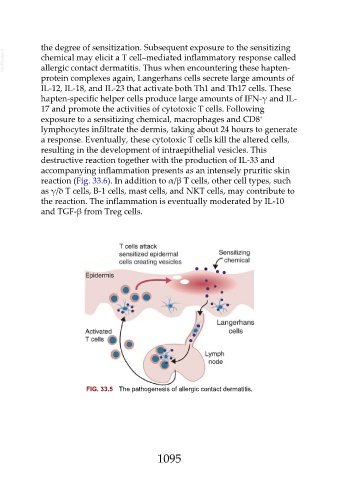Page 1095 - Veterinary Immunology, 10th Edition
P. 1095
the degree of sensitization. Subsequent exposure to the sensitizing
VetBooks.ir chemical may elicit a T cell–mediated inflammatory response called
allergic contact dermatitis. Thus when encountering these hapten-
protein complexes again, Langerhans cells secrete large amounts of
IL-12, IL-18, and IL-23 that activate both Th1 and Th17 cells. These
hapten-specific helper cells produce large amounts of IFN-γ and IL-
17 and promote the activities of cytotoxic T cells. Following
exposure to a sensitizing chemical, macrophages and CD8 +
lymphocytes infiltrate the dermis, taking about 24 hours to generate
a response. Eventually, these cytotoxic T cells kill the altered cells,
resulting in the development of intraepithelial vesicles. This
destructive reaction together with the production of IL-33 and
accompanying inflammation presents as an intensely pruritic skin
reaction (Fig. 33.6). In addition to α/β T cells, other cell types, such
as γ/δ T cells, B-1 cells, mast cells, and NKT cells, may contribute to
the reaction. The inflammation is eventually moderated by IL-10
and TGF-β from Treg cells.
FIG. 33.5 The pathogenesis of allergic contact dermatitis.
1095

